Pentagonal tiling
In geometry, a pentagonal tiling is a tiling of the plane where each individual piece is in the shape of a pentagon.
A regular pentagonal tiling on the Euclidean plane is impossible because the internal angle of a regular pentagon, 108°, is not a divisor of 360°, the angle measure of a whole turn.
Monohedral convex pentagonal tilings

Fifteen types of convex pentagons are known to tile the plane monohedrally (i.e. with one type of tile).[1] The most recent one was discovered in 2015. It is not known whether this list is complete.[2] Bagina (2011) showed that there are only eight edge-to-edge convex types, a result obtained independently by Sugimoto (2012).
Each enumerated tiling family contains pentagons that belong to no other type; however, some individual pentagons may belong to multiple types. In addition, some of the pentagons in the known tiling types also permit alternative tiling patterns beyond the standard tiling exhibited by all members of its type.
The sides of length a, b, c, d, e are directly clockwise from the angles at vertices A, B, C, D, E respectively. (Thus, A, B, C, D, E are opposite to d, e, a, b, c respectively.)
| 1 | 2 | 3 | 4 | 5 | |
|---|---|---|---|---|---|
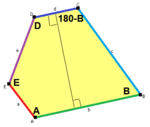 B+C=180° A+D+E=360° |
 c=e B+D=180° |  a = b, d = c + e A = C = D = 120° | 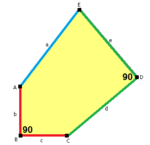 b = c, d = e B = D = 90° |  a = b, d = e A = 60°, D = 120° | |
| 6 | 7 | 8 | 9 | 10 | |
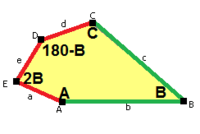 a = d = e, b = c B + D = 180°, 2B = E |  b = c = d = e B + 2E = 2C + D = 360° | 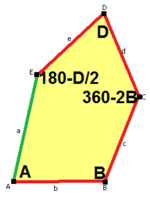 b = c = d = e 2B + C = D + 2E = 360° |
 b = c = d = e 2A + C = D + 2E = 360° |
 a = b = c + e A = 90°, B + E = 180°, B + 2C = 360° | |
| 11 | 12 | 13 | 14 | 15 | |
 2a + c = d = e A = 90°, 2B + C = 360° C + E = 180° |  2a = d = c + e A = 90°, 2B + C = 360° C + E = 180° |  d = 2a = 2e B = E = 90°, 2A + D = 360° |
 2a = 2c = d = e A = 90°, B ≈ 145.34°, C ≈ 69.32°, D ≈ 124.66°, E ≈ 110.68° (2B + C = 360°, C + E = 180°). |  a = c = e, b = 2a A = 150°, B = 60°, C = 135°, D = 105°, E = 90° | |
Many of these monohedral tile types have degrees of freedom. These freedoms include variations of internal angles and edge lengths. In the limit, edges may have lengths that approach zero or angles that approach 180°. Types 1, 2, 4, 5, 6, 7, 8, 9, and 13 allow parametric possibilities with nonconvex prototiles.
Periodic tilings are characterised by their wallpaper group symmetry, for example p2 (2222) is defined by four 2-fold gyration points. This nomenclature is used in the diagrams below, where the tiles are also colored by their k-isohedral positions within the symmetry.
A primitive unit is a section of the tiling that generates the whole tiling using only translations, and is as small as possible.
Reinhardt (1918)
Reinhardt (1918) found the first five types of pentagonal tile. All five can create isohedral tilings, meaning that the symmetries of the tiling can take any tile to any other tile (more formally, the automorphism group acts transitively on the tiles).
B. Grünbaum and G. C. Shephard have shown that there are exactly twenty-four distinct "types" of isohedral tilings of the plane by pentagons according to their classification scheme.[3] All use Reinhardt's tiles, usually with additional conditions necessary for the tiling. There are two tilings by all type 2 tiles, and one by all of each of the other four types. Fifteen of the other eighteen tilings are by special cases of type 1 tiles. Nine of the twenty-four tilings are edge-to-edge.[4]
There are also 2-isohedral tilings by special cases of type 1, type 2, and type 4 tiles, and 3-isohedral tilings, all edge-to-edge, by special cases of type 1 tiles. There is no upper bound on k for k-isohedral tilings by certain tiles that are both type 1 and type 2, and hence neither on the number of tiles in a primitive unit.
The wallpaper group symmetry for each tiling is given, with orbifold notation in parentheses. A second lower symmetry group is given if tile chirality exists, where mirror images are considered distinct. These are shown as yellow and green tiles in those cases.
Type 1
There are many tiling topologies that contain type 1 pentagons. Five example topologies are given below.
| p2 (2222) | cmm (2*22) | cm (*×) | pmg (22*) | pgg (22×) | p2 (2222) | cmm (2*22) |
|---|---|---|---|---|---|---|
| p1 (°) | p2 (2222) | p2 (2222) | ||||
 |  |  |  |  |  |  |
| 2-tile primitive unit | 4-tile primitive unit | |||||
 B + C = 180° A + D + E = 360° |
 a = c, d = e A + B = 180°, A + D + E = 360° |
a = c A + B = 180°, C + D + E = 360° |
 a = e B + C = 180°, A + D + E = 360° |
 d = c + e A = 90°, C + D = 180° 2B + C = 360° B + E = 270° | ||
Type 2
These type 2 examples are isohedral. The second is an edge-to-edge variation. They both have pgg (22×) symmetry. If mirror image protile tiles (yellow and green) are considered distinct, the symmetry is p2 (2222).
| pgg (22×) | |
|---|---|
| p2 (2222) | |
 |
 |
| 4-tile primitive unit | |
 c = e B + D = 180° |
 c = e, d = b B + D = 180° |
Types 3, 4, and 5
| Type 3 | Type 4 | Type 5 | ||||
|---|---|---|---|---|---|---|
| p3 (333) | p3m1 (*333) | p4 (442) | p4g (4*2) | p6 (632) | ||
 |  |  |  |  |  | 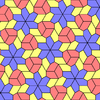 |
 |
 |
|||||
| 3-tile primitive unit | 4-tile primitive unit | 6-tile primitive unit | 18-tile primitive unit | |||
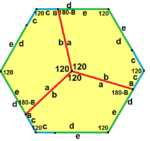 a = b, d = c + e A = C = D = 120° |
 b = c, d = e B = D = 90° |
 a = b, d = e A = 60°, D = 120° |
 a = b = c, d = e A = 60°, B = 120°, C = 90° D = 120°, E = 150° | |||
Kershner (1968) Types 6, 7, 8
Kershner (1968) found three more types of pentagonal tile, bringing the total to eight. He claimed incorrectly that this was the complete list of pentagons that can tile the plane.
These examples are 2-isohedral and edge-to-edge. Type 8 has chiral pairs of tiles, which are colored as pairs in yellow-green and the other as two shades of blue. The pgg symmetry is reduced to p2 with distinct chiral pairs. The pgg symmetry is reduced to p2 when chiral pairs are considered distinct.
| Type 6 | Type 6 (Also type 5) | Type 7 | Type 8 | |
|---|---|---|---|---|
| p2 (2222) | pgg (22×) | pgg (22×) | ||
| p2 (2222) | p2 (2222) | |||
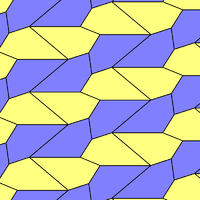 |  |  |  | |
 |
 |
 | ||
 a = d = e, b = c B + D = 180°, 2B = E |  a = d = e, b = c B = 60°, A = C = D = E = 120° |  b = c = d = e B + 2E = 2C + D = 360° |  b = c = d = e 2B + C = D + 2E = 360° | |
 4-tile primitive unit |  4-tile primitive unit |  8-tile primitive unit |  8-tile primitive unit | |
James (1975) Type 10
In 1975 Richard E. James III found a ninth type, after reading about Kershner's results in Martin Gardner's "Mathematical Games" column in Scientific American magazine of July 1975 (reprinted in Gardner (1988)). It is indexed as type 10. The tiling is 3-isohedral and non-edge-to-edge.
| p2 (2222) | cmm (2*22) |
|---|---|
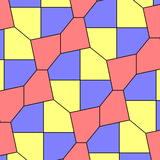 |  |
 | |
 a=b=c+e A=90, B+E=180°, B+2C=360° |  a=b=2c=2e A=B=E=90°, C+D=135° |
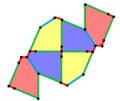 6-tile primitive unit | |
Rice (1977) Types 9,11,12,13
Marjorie Rice, an amateur mathematician, discovered four new types of tessellating pentagons in 1976 and 1977.[4][5]
All four tilings are 2-isohedral. The chiral pairs of tiles are colored in yellow and green for one isohedral set, and two shades of blue for the other set. The pgg symmetry is reduced to p2 when the chiral pairs are considered distinct.
The tiling by type 9 tiles is edge-to-edge, but the others are not.
Each primitive unit contains eight tiles.
| Type 9 | Type 11 | Type 12 | Type 13 |
|---|---|---|---|
| pgg (22×) | |||
| p2 (2222) | |||
 |  |  |  |
 |
 |
 |
 |
 b=c=d=e 2A+C=D+2E=360° |  2a+c=d=e A=90°, 2B+C=360° C+E=180° |  2a=d=c+e A=90°, 2B+C=360° C+E=180° |  d=2a=2e B=E=90°, 2A+D=360° |
 8-tile primitive unit |  8-tile primitive unit |  8-tile primitive unit |  8-tile primitive unit |
Stein (1985) Type 14
A 14th convex pentagon type was found by Rolf Stein in 1985.[6]
The tiling is 3-isohedral and non-edge-to-edge. It has completely determined tiles, with no degrees of freedom. Some exact equations are: , , , . Other relations can easily be deduced.
The primitive units contain six tiles respectively. It has p2 (2222) symmetry.
 |
 2a=2c=d=e A=90°, B≈145.34°, C≈69.32°, D≈124.66°, E≈110.68° (2B+C=360°, C+E=180°). |
 6-tile primitive unit |
Mann/McLoud/Von Derau (2015) Type 15
University of Washington Bothell mathematicians Casey Mann, Jennifer McLoud, and David Von Derau discovered a 15th monohedral tiling convex pentagon in 2015 using a computer algorithm.[7] The paper was published in October 2015.[8]
It is 3-isohedral and non-edge-to-edge, drawn with 6 colors, 2 shades of 3 colors, representing chiral pairs of the three isohedral positions. The pgg symmetry is reduced to p2 when the chiral pairs are consided distinct.
It has completely determined tiles, with no degrees of freedom. The primitive units contain twelve tiles respectively. It has pgg (22×) symmetry, and p2 (2222) if chiral pairs are considered distinct.
 (Larger image) |
 a=c=e, b=2a, d=√(2+√3)a A=150°, B=60°, C=135°, D=105°, E=90° |
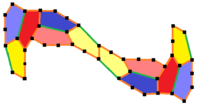 12-tile primitive unit |
Nonperiodic monohedral pentagons tilings

Nonperiodic monohedral pentagons tilings can also be constructed, like this example with 6-fold rotational symmetry by Michael Hirschhorn. Angles are A = 140°, B = 60°, C = 160°, D = 80°, E = 100° [9]
Dual uniform tilings
There are three isohedral pentagonal tilings generated as duals of the uniform tilings, those with 5-valence vertices. They represent special higher symmetry cases of the 15 monohedral tilings above. Uniform tilings and their duals are all edge-to-edge. These dual tilings are also called Laves tilings. The symmetry of the uniform dual tilings is the same as the uniform tilings. Because the uniform tilings are isogonal, the duals are isohedral.
| cmm (2*22) | p4g (4*2) | p6 (632) |
|---|---|---|
 |
 |
 |
| Prismatic pentagonal tiling Instance of type 1[10] |
Cairo pentagonal tiling Instance of type 4[10][11] |
Floret pentagonal tiling Instance of types 1, 2 and 5[10] |
 120°, 120°, 120°, 90°, 90° V3.3.3.4.4 |
 120°, 120°, 90°, 120°, 90° V3.3.4.3.4 |
 120°, 120°, 120°, 120°, 60° V3.3.3.3.6 |
Dual k-uniform tilings
The k-uniform tilings with valence-5 vertices also have pentagonal dual tilings, containing the same three shaped pentagons as the semiregular duals above, but contain a mixture of pentagonal types. A k-uniform tiling has a k-isohedral dual tiling and are represented by different colors and shades of colors below.
For example these 2, 3, 4, and 5-uniform duals are all pentagonal:[12][13]
| 2-isohedral | 3-isohedral | |||
|---|---|---|---|---|
| p4g (4*2) | pgg (22×) | p2 (2222) | p6 (*632) | |
 |
 |
 |
 |
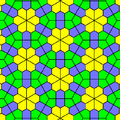 |
| 4-isohedral | 5-isohedral | |||
| pgg (22×) | p2 (2222) | p6m (*632) | ||
 |
 |
 |
 |
 |
| 5-isohedral | ||||
| pgg (22×) | p2 (2222) | |||
 |
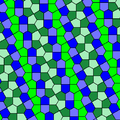 |
 |
 |
 |
Pentagonal/hexagonal tessellation

Pentagons have a peculiar relationship with hexagons. As demonstrated graphically below, some types of hexagons can be subdivided into pentagons. For example, a regular hexagon bisects into two type 1 pentagons. Subdivision of convex hexagons is also possible with three (type 3), four (type 4) and nine (type 3) pentagons.
By extension of this relation, a plane can be tessellated by a single pentagonal prototile shape in ways that generate hexagonal overlays. For example:
 Planar tessellation by a single pentagonal prototile (type 1) with overlays of regular hexagons (each comprising 2 pentagons). |
 Planar tessellation by a single pentagonal prototile (type 3) with overlays of regular hexagons (each comprising 3 pentagons). |
 Planar tessellation by a single pentagonal prototile (type 4) with overlays of semiregular hexagons (each comprising 4 pentagons). |
 Planar tessellation by a single pentagonal prototile (type 3) with overlays of two sizes of regular hexagons (comprising 3 and 9 pentagons respectively). |
Non-convex pentagons

With pentagons that are not required to be convex, additional types of tiling are possible. An example is the sphinx tiling, an aperiodic tiling formed by a pentagonal rep-tile.[14] The sphinx may also tile the plane periodically, by fitting two sphinx tiles together to form a parallelogram and then tiling the plane by translates of this parallelogram,[14] a pattern that can be extended to any non-convex pentagon that has two consecutive angles adding to 2π.
It is possible to divide an equilateral triangle into three congruent non-convex pentagons, meeting at the center of the triangle, and to tile the plane with the resulting three-pentagon unit.[15] A similar method can be used to subdivide squares into four congruent non-convex pentagons, or regular hexagons into six congruent non-convex pentagons, and then tile the plane with the resulting unit.
Regular pentagonal tilings in non-Euclidean geometry
A dodecahedron can be considered a regular tiling of 12 pentagons on the surface of a sphere, with Schläfli symbol {5,3}, having three pentagons around each vertex.
In the hyperbolic plane, there are tilings of regular pentagons, for instance order-4 pentagonal tiling, {5,4}, having four pentagons around each vertex. Higher order regular tilings {5,n} can be constructed on the hyperbolic plane, ending in {5,∞}.
| Sphere | Hyperbolic plane | |||||
|---|---|---|---|---|---|---|
 {5,3} |
 {5,4} |
 {5,5} |
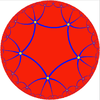 {5,6} |
 {5,7} |
 {5,8} |
...{5,∞} |
Irregular hyperbolic plane pentagonal tilings
There are an infinite number of dual uniform tilings in hyperbolic plane with isogonal irregular pentagonal faces. They have face configurations as V3.3.p.3.q.
| 7-3 | 8-3 | 9-3 | ... | 5-4 | 6-4 | 7-4 | ... | 5-5 |
|---|---|---|---|---|---|---|---|---|
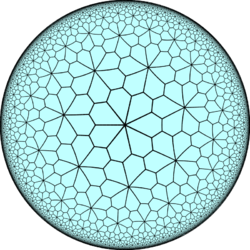 V3.3.3.3.7 |
V3.3.3.3.8 | V3.3.3.3.9 | … |  V3.3.4.3.5 |
V3.3.4.3.6 | V3.3.4.3.7 | … | V3.3.5.3.5 |
References
- ↑ Tilings and Patterns, Sec. 9.3 Other Monohedral tilings by convex polygons
- ↑ Peralta, Eyder (14 August 2015), "With Discovery, 3 Scientists Chip Away At An Unsolvable Math Problem", NPR, retrieved 15 August 2015
- ↑ Grünbaum; Shephard 1978.
- 1 2 Schattschneider 1978.
- ↑ "Tessellations - Intriguing Tessellations". google.com. Retrieved 22 August 2015.
- ↑ Schattschneider 1985.
- ↑ Bellos, Alex (11 August 2015). "Attack on the pentagon results in discovery of new mathematical tile". The Guardian.
- ↑ 15th pentagon type tiling ; Convex pentagons that admit i-block transitive tilings
- ↑ Tiling the Plane with Congruent Pentagons, Doris Schattschneider, Mathematics Magazine, January 1978, Fig 12
- 1 2 3 Reinhardt, Karl (1918), Über die Zerlegung der Ebene in Polygone, Dissertation Frankfurt am Main (in German), Borna-Leipzig, Druck von Robert Noske, pp. 77–81 (caution: there is at least one obvious mistake within this paper, i.e. γ+δ angle sum needs to equal π, not 2π for the first two tiling types defined on page 77)
- ↑ Cairo pentagonal tiling generated by a pentagon type 4 query and by a pentagon type 2 tiling query on wolframalpha.com (caution: the wolfram definition of pentagon type 2 tiling does not correspond with type 2 defined by Reinhardt in 1918)
- ↑ Chavey 1989.
- ↑ n-uniform tilings, Brian Galebach
- 1 2 Godrèche 1989.
- ↑ Gerver 2003.
Bibliography
- Bagina, Olga (2004), "Tiling the plane with congruent equilateral convex pentagons", Journal of Combinatorial Theory. Series A, 105 (2): 221–232, doi:10.1016/j.jcta.2003.11.002, ISSN 1096-0899, MR 2046081
- Bagina, Olga (2011), Мозаики из выпуклых пятиугольников [Tilings of the plane with convex pentagons], Vestnik (in Russian), Kemerovo State University, 4 (48): 63–73, ISSN 2078-1768, retrieved 29 January 2013
- Chavey, D. (1989), "Tilings by Regular Polygons—II: A Catalog of Tilings", Computers & Mathematics with Applications, 17: 147–165, doi:10.1016/0898-1221(89)90156-9
- Gardner, Martin (1988), "Tiling with Convex Polygons", Time travel and other mathematical bewilderments, New York: W. H. Freeman and Company, ISBN 0-7167-1925-8, MR 0905872
- Gerver, M. L. (2003), "Theorems on tessellations by polygons", Sbornik: Mathematics, 194 (6): 879–895, doi:10.1070/sm2003v194n06abeh000743
- Godrèche, C. (1989), "The sphinx: a limit-periodic tiling of the plane", Journal of Physics A: Mathematical and General, 22 (24): L1163–L1166, doi:10.1088/0305-4470/22/24/006, MR 1030678
- Grünbaum, Branko; Shephard, Geoffrey C. (1978), "Isohedral tilings of the plane by polygons", Commentarii Mathematici Helvetici, 53: 542–571, doi:10.5169/seals-40786, ISSN 0010-2571
- Grünbaum, Branko; Shephard, Geoffrey C. (1987), "Tilings by polygons", Tilings and Patterns, New York: W. H. Freeman and Company, ISBN 0-7167-1193-1, MR 0857454
- Hirschhorn, M. D.; Hunt, D. C. (1985), "Equilateral convex pentagons which tile the plane", Journal of Combinatorial Theory. Series A, 39 (1): 1–18, doi:10.1016/0097-3165(85)90078-0, ISSN 1096-0899, MR 787713
- Kershner, Richard (1968), "On paving the plane", American Mathematical Monthly, 75: 839–844, doi:10.2307/2314332, ISSN 0002-9890, JSTOR 2314332, MR 0236822
- Reinhardt, Karl (1918), Über die Zerlegung der Ebene in Polygone, Dissertation Frankfurt a.M. (in German), Borna-Leipzig, Druck von Robert Noske,
- Schattschneider, Doris (1978), "Tiling the plane with congruent pentagons", Mathematics Magazine, 51 (1): 29–44, doi:10.2307/2689644, ISSN 0025-570X, JSTOR 2689644, MR 0493766
- Schattschneider, Doris (1985), "A new pentagon tiler", Mathematics Magazine, 58 (5): 308, The cover has a picture of the new tiling
- Sugimoto, Teruhisa; Ogawa, Tohru (2005), "Systematic study of convex pentagonal tilings. I. Case of convex pentagons with four equal-length edges", Forma, 20: 1–18, MR 2240616
- Sugimoto, Teruhisa; Ogawa, Tohru (2009), "Systematic study of convex pentagonal tilings, II: tilings by convex pentagons with four equal-length edges", Forma, 24 (3): 93–109, MR 2868775; Errata, Forma 25 (1): 49, 2010, MR 2868824
- Sugimoto, Teruhisa (2012), "Convex pentagons for edge-to-edge tiling, I.", Forma, 27 (1): 93–103, MR 3030316
External links
| Wikimedia Commons has media related to Pentagonal tilings. |
- Pentagon Tilings
- The 14 Pentagons that Tile the Plane
- 15 (monohedral) Tilings with a convex pentagonal tile with k-isohedral colorings
- Code to display the 14th pentagon type tiling
- Code to display the 15th pentagon type tiling
- Tiling the Plane with Congruent Pentagons, Doris Schattschneider, Mathematics Magazine, Vol. 51, (1978), pp. 29–44,
